 Home > CR Interviews
Home > CR Interviews CR Holiday Interview #5—Shaenon Garrity On Achewood
posted June 19, 2010
CR Holiday Interview #5—Shaenon Garrity On Achewood
posted June 19, 2010

 Shaenon Garrity
Shaenon Garrity is a veteran of webcomics cartooning known primarily for her long-running series
Narbonic. A well-regarded editor in addition to a creator lauded for efforts like the currently running
Skin Horse (with Jeffrey Channing Wells), Garrity is the rare cartoonist that also writes extremely well
about comics. She's
a columnist at ComiXology, a
featured blogger at The Comics Journal and welcome on this site any time she'd like. From her list I chose
Achewood, perhaps the greatest of this decade's popular webcomics.
*****
TOM SPURGEON: Shaenon, you made fun of me a little bit for picking Achewood
off of your list, and when I asked you about it you said you were pretty certain that I was going to choose that one. What is it about Achewood
that makes it such an obvious emblematic work of this decade? Is it just really good? Does it have qualities that allow it to be better appreciated than some other strips by print-focused comics fans?
SHAENON GARRITY: Snarky answer: because it was the only comic on the list by a white American male, so I figured the critical consensus was that it was the most important and universal.
But I know you probably just wanted me to talk about webcomics. And
Achewood is kind of the quintessential webcomic -- or, more precisely, the quintessential webcomic that's any good. The quality that allows it to be better appreciated by print-focused comics fans is not sucking. I had some other webcomics on the list that are equally good, but they're not as well-known, I guess, or of representative of people's idea of webcomics.
By the way, in your e-mail you said you didn't know what I was going to say except that it would be funny. I'm sorry to tell you that I will be funny only by quoting all the good lines out of
Achewood strips.
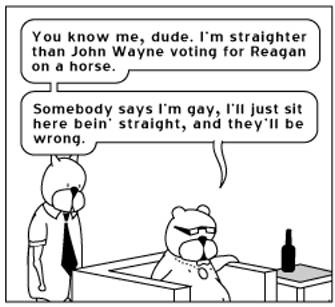 SPURGEON: How did you become aware of the strip? What was your initial reaction to it? Has that reaction changed over time and if so, how?
SPURGEON: How did you become aware of the strip? What was your initial reaction to it? Has that reaction changed over time and if so, how?
GARRITY: I think I discovered
Achewood the way most people discover most webcomics: enough people linked to it that I could no longer ignore it. I can't remember which strip I read first, but it might have been the one where Lie Bot shows his ass. That is still a damn funny strip.
 SPURGEON: Has the strip itself changed, do you think? Was there a point at which it kind of settled into its current incarnation?
SPURGEON: Has the strip itself changed, do you think? Was there a point at which it kind of settled into its current incarnation?
GARRITY: I'm looking through the archives now, and can I just say the site seems to be designed to discourage people from reading all the way through? If you use the "Jump to a Story Arc" dropdown, the earliest arc you can reach is "The Party," six months into the strip's run. You have to dig a little to get to the actual first strip, October 2001, "
Philippe is standing on it," a three-paneler that's odd and incomprehensible, yet so strangely compelling it's inspired pop songs.
This may be deliberate on Onstad's part. In the new
Achewood collection,
Worst Song, Played on Ugliest Guitar, he's pretty harsh on his first year of strips. Probably harsher than he needs to be, but it's true that the early
Achewood is not radically different from a lot of strips that were nosing around the Internet at the dawn of the new millennium. There was a time when sketchily-drawn cartoon animals saying bizarre and/or dirty things was a burgeoning genre.
Achewood seemed to be going for something more interesting than most, but it wasn't that much of a standout.
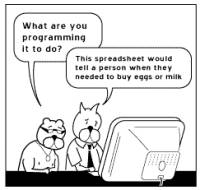
"The Party" is important as the storyline that introduced Roast Beef ("Roast Beef, the other cat / Neither Ray nor Pat"). The relationship between Roast Beef and Ray has since become the heart of the strip, whereas in the early strips it's more about the bears and Philippe. But that relationship only gels in the next big storyline, "Ray's Startup." The
first strip in "Ray's Startup" encapsulates everything you need to know about these two characters. Ray wanders in (smoking a cigarette), he asks Roast Beef why he's fiddling around on the computer, and Beef answers, "I guess it's the only thing I'm really good at." That's Roast Beef, all right. In the last panel, Ray has adapted the program Beef is writing, a spreadsheet reminding him to buy eggs and milk, into a makeshift Internet startup and is enthusiastically shilling the new product. This basic premise will be repeated, with minor adjustments (say, replacing shopping spreadsheets with prosthetic testicles for cell phones), many, many times over the course of
Achewood.
All the key components are in place by about a year into the strip. Personally, I don't think
Achewood becomes consistently, untouchably brilliant until mid-2003 with "
Oregon Trail," where all the characters play the antique educational PC game and get seduced by Hiram the blacksmith. That's about the point where Onstad starts to put a lot of work into crafting funny turns of phrase, really punching up the characters' individual voices ("Dang what in the heck Ray / How did you get syphilis"). This is immediately followed by Ray crank-calling comic-strip characters ("I'm ready, dogg. I'm callin' Garfield"): another hilarious series of strips.
SPURGEON: If you'll indulge me, because I know there's a chance this line of reasoning may have no interest to you at all, but where does Achewood
fit into a continuity of webcomics from this decade? My own perception of webcomics is fractured. They're admittedly all over the place. But I can also conceive of that group of Scott McCloud stamp-approved formalists from early in the decade -- or from the previous -- and also this wave of more traditionally formatted strips with a huge, ongoing narrative component. Achewood
I see as one of those works between those two general camps, along with Get Your War On and PBF, where the basic strip format was used but at the same time gently subverted. I'm way more interested in your opinion, though, and not just whether or not I have way too much time on my hands, because that's obviously true.
GARRITY: To be honest, I don't have a clear concept of the continuity and evolution of webcomics beyond a certain point. By now it's an enormous field, and, beyond grouping some works into broad categories (stick figures, furries, two gamers on a couch shilling consumer products -- what a beautiful, gory layout!), it's very hard to gauge where individual comics come from or how they fit into a larger movement. One thing I do find interesting about
Achewood, which I've said elsewhere, is that it's kind of a stereotypical "bad webcomic." It has the stiff, cut-and-paste look of many webcomics, it's never followed a reliable update schedule, the plots have a thrown-together quality, and, again, it's about cartoon animals saying dirty things. There are a lot of bad webcomics that fit that description. But by some alchemy
Achewood is really good. I hope it doesn't come off like I'm putting the strip down; I deeply admire what Onstad has done with his material, because I can't do anything remotely like that. It's like improv jazz.
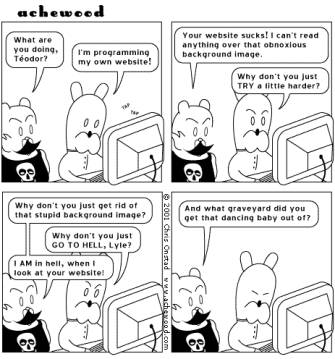 SPURGEON: How are
SPURGEON: How are Achewood
and Onstad perceived by other webcomics cartoonists?
GARRITY: Like I said, webcomics is such a huge field that it's impossible to generalize. But I don't know anyone who doesn't like
Achewood. I've seen several of my cartoonist friends go through the same phase of discovering the strip and being unable to talk about anything else for weeks. Sitting down and reading through the archives is mind-blowing.
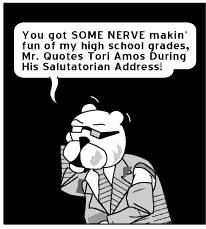 SPURGEON: Onstad's highest accolades come to him as a writer. How do you feel about his art? I think it's effective, but I can't tell if that's just because I'm used to it or if I think it actually has qualities that benefit the strip. When do you think the art in
SPURGEON: Onstad's highest accolades come to him as a writer. How do you feel about his art? I think it's effective, but I can't tell if that's just because I'm used to it or if I think it actually has qualities that benefit the strip. When do you think the art in Achewood
is at its most effective, and what qualities does it have at those times?
GARRITY: Onstad is one of those cartoonists, like
Lynda Barry, who isn't a good "draw-er" in the sense of traditional draftsmanship or illustration skills, but has a strong grasp of visual storytelling and overall design, which, in my opinion, are much more important skills for cartooning. He knows the strengths and limitations of his art and how to make it work for him. If, for example, you usually create your art by cutting and pasting elements together -- which many, many webcartoonists, Onstad included, do -- it limits the range and subtlety of expression you can get from your characters. In that case, if you're smart, you make the relative blankness of the characters' faces work for you: draw large, simple faces onto which readers can project themselves, and make more of the emoting and personality happen in the dialogue and panel-to-panel storytelling. Which is what Onstad does.
He's also got a great sense of comic timing. Check out the recent strip where Cornelius drives off with his stripper girlfriend for the first time. Something about the timing of each event on the drive cracks me up.
There's also a lot of good design stuff in
Achewood. Onstad
seems to be a fan of
Chris Ware, and in fact his work and Ware's are similar in a lot of ways.
 SPURGEON: I re-read a bunch of
SPURGEON: I re-read a bunch of Achewood
before this interview, and I wondered if there was a good question about how
the strip is funny. I think that a lot of it is execution, of course, the precision he brings to the characters and the lean, to-the-point quality of the gags. But conceptually, I wonder how I would describe what he does. Is there an Achewood
worldview that can be described? Part of me thinks that he gets great mileage out of these raw characters crashing into a peculiarly complex and idiosyncratic way of doing things, but I'm pretty sure that doesn't come close to describing it.
GARRITY: It's elusive, isn't it? A lot of it is in the dialogue, in the characters having funny and distinctive voices, but it's more than that. I can't pin it down.
The Wikipedia entry cracks me up with its efforts to explain the strips: "Mr. Bear and Téodor are discussing Téodor's confusion over a drum machine. Mr. Bear informs Téodor that there is an instruction manual. However, Philippe is standing on it." Oh, yeah, I see how that's funny. Thanks, Wikipedia!
But why is it so funny? I don't really know. All I can offer is that it's funnier when characters talk without punctuation, and Onstad gets a lot of mileage out of that.
SPURGEON: [laughs] One of the things I've never been able to process because it's just too weird and too incredibly awesome at the same time is the supplementary blogging he's done. I don't even have words to describe that kind of effort. What did you think of that writing? Is there anything in webcomics that compares to that kind of sustained, sideways, second take on a comics offering?
GARRITY: I love the
Achewood blogs. Onstad doesn't update them all the time, but when he does he puts a lot of effort into them. I think my favorite sequence was a series of posts by Ray and Philippe in which it becomes clear that they're unknowingly planning parties on the same day. Comedy gold! (This is another key to
Achewood being funny: mining classic comedy situations. Do not underestimate the power of a party-conflict story.) Everyone goes to Philippe's party, where they run in the yard and wash the dog, and no one shows up at Ray's party ("ENORMOUS by Ray Smuckles"). At the end Ray's standing around wondering why no one came to his party. There's something about the gaps left in the blogs, the little mental leaps left to the reader, that's very appropriate to comics. Scott McCloud would call it "closure," wouldn't he?
I also like it when events from the blogs leak into the strip. I think the bar Cornelius starts, the Dude and Catastrophe, was discussed in the blogs for a long time before it showed up in the strip. Of course the strip never mentioned the whole parallel story going on in Pat's blog at the same time, where he tries to start a vegan restaurant as some oblique form of competition with Cornelius, and it goes horribly wrong. It's all brilliant stuff.


 SPURGEON: For those reading who have never quite taken the plunge: is there a storyline or run of strips that you feel was particularly well done? Do you think
SPURGEON: For those reading who have never quite taken the plunge: is there a storyline or run of strips that you feel was particularly well done? Do you think The Great Outdoor Fight
breaking out a bit was beneficial or not to reading and understanding the wider work? Was that a good ambassador for the strip?
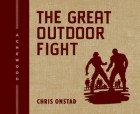 GARRITY: The Great Outdoor Fight
GARRITY: The Great Outdoor Fight encapsulates a lot of key elements of
Achewood, so it's a good introduction. It's about the relationship between Roast Beef and Ray, it opens with Ray starting a bizarre business venture, and it's got nearly all the characters in some role, even if most of them are just spectators to the Beef/Ray drama. It also has a great climax and ending, which is one area where
Achewood can be a little weak. A lot of storylines just end rather than building to a climax, but the GOF builds and builds and builds.
Great Outdoor Fight mania was so crazy! To this day I'm not sure how it happened, but I was there, my son. I realized things were spiraling out of control when some fans started a GOF wiki and started writing entries for dozens and dozens of invented Outdoor Fights and Fighters of the past. My friend and collaborator Jeff Wells wrote at least one.
SPURGEON: It occurs to me that Achewood
has done a lot of things in order to fund itself, including premium offerings, licensing and print collections. Although I don't know the specifics, Achewood
has the reputation of being a successful commercial endeavor in addition to its creative success. The constant pursuit of the best kind of funding has been a significant part of making webcomics over the last decade. With Achewood
with an example or maybe more generally, is there anything about the act of publishing in that basic "find the money to support it" way that you think may impinge on the creative side of things? Is the basic webcomics experience different than more traditional efforts in cartooning?
 GARRITY:
GARRITY: Okay, here's the one secret I know about Chris Onstad, based on my extremely limited personal contact with him: he's sort of a combination of Roast Beef and Ray. Underneath his shyness, he's a good businessman, and he seems to have unlimited energy for promoting
Achewood and developing its world. He's tried every possible revenue stream in webcomics. Hell, he was even in the
Modern Tales family for a while (he had bonus content on
Serializer.net before moving it onto a subscriber-only section on his own site, which continues to this day).
One thing I admire is the oddness of some of the projects he's tried. He's done
a series of Achewood cookbooks. He has a hot sauce called
Ray's Rad Chilies. I seem to recall that he once wrote and self-published a book the characters were reading. His
prints and posters are unique and attractive even if you're not into the strip.
I am singularly awful at making money from webcomics, so I'm in awe of all of this.
SPURGEON: You're the only with whom I'm talking about webcomics, and to take it back to our first question I wondered if you wanted to point out two or three choices that might have been less obvious than Achewood
, but perhaps just as emblematic in their own way of the that group of comics in the decade just past.
GARRITY: I had some on my list, but it's really hard to be "emblematic" with webcomics, because it's such a huge and diverse field. In the balance,
Achewood probably comes the closest.
*****
*
Achewood, Chris Onstad, Self-Published Webcomic, 2001-present.
*****
* images from various
Achewood cartoons, all copyright 2009 Chris Onstad
*****
This year's CR Holiday Interview Series features some of the best writers about comics talking about emblematic -- by which we mean favorite, representative or just plain great -- books from the ten-year period 2000-2009. The writer provides a short list of books, comics or series they believe qualify; I pick one from their list that sounds interesting to me and we talk about it. It's been a long, rough and fascinating decade. Our hope is that this series will entertain from interview to interview but also remind all of us what a remarkable time it has been and continues to be for comics as an art form. We wish you the happiest of holidays no matter how you worship or choose not to. Thank you so much for reading
The Comics Reporter.
*
CR Holiday Interview One: Sean T. Collins On Blankets
*
CR Holiday Interview Two: Frank Santoro On Multiforce
*
CR Holiday Interview Three: Bart Beaty On Persepolis
*
CR Holiday Interview Four: Kristy Valenti On So Many Splendid Sundays
*****
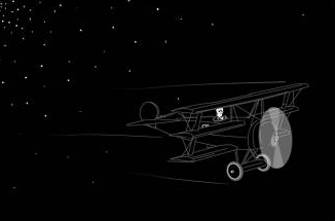
*****
*****


